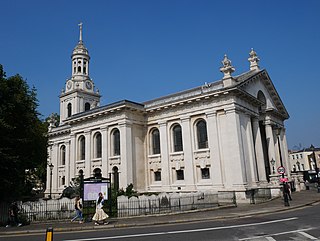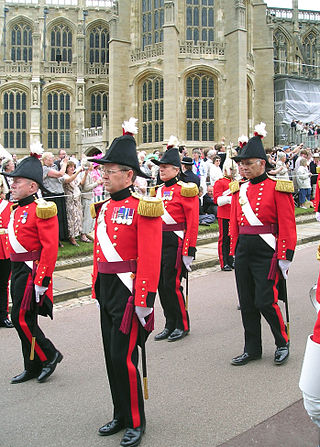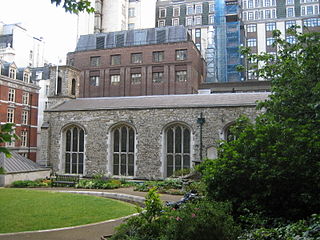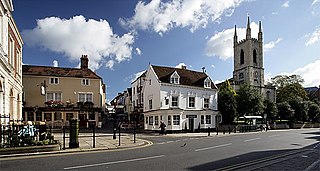
The Most Noble Order of the Garter is an order of chivalry founded by Edward III of England in 1348. The most senior order of knighthood in the British honours system, it is outranked in precedence only by the decorations of the Victoria Cross and the George Cross. The Order of the Garter is dedicated to the image and arms of Saint George, England's patron saint.

St Alfege Church is an Anglican church in the centre of Greenwich, part of the Royal Borough of Greenwich in London. It is of medieval origin and was rebuilt in 1712–1714 to the designs of Nicholas Hawksmoor.

St Clement Danes is an Anglican church in the City of Westminster, London. It is now situated near the 19th-century Royal Courts of Justice on the Strand. Although the first church on the site was reputedly founded in the 9th century by the Danes, the current building replaced the medieval church building and was completed in 1682 by celebrated architect Sir Christopher Wren. Wren's building was gutted by Luftwaffe bombing raids during the Blitz and not restored until 1958, when it was adapted to its current function as the central church of the Royal Air Force.

The Military Knights of Windsor, originally the Alms Knights and informally the Poor Knights, are retired military officers who receive a pension and accommodation at Windsor Castle, and who provide support for the Order of the Garter and for the services of St. George's Chapel, Windsor Castle. They are commanded by a senior retired officer as Governor of the Military Knights of Windsor.

Wellington Barracks is a military barracks in Westminster, central London, for the Foot Guards battalions on public duties in that area. The building is located about 300 yards (270 m) from Buckingham Palace, allowing the guard to be able to reach the palace very quickly in an emergency, and lies between Birdcage Walk and Petty France. Three companies are based at the barracks, as well as all of the Foot Guards bands and the regimental headquarters.
Edmund Horace Fellowes was a Church of England clergyman and musical scholar who became well known for his work in promoting the revival of sixteenth and seventeenth century English music.

Christ Church Cathedral, in Stanley, Falkland Islands, is the southernmost Anglican cathedral in the world. It is the parish church of the Falkland Islands, South Georgia and the British Antarctic Territories. The Parish of the Falkland Islands is part of the Anglican Communion. The rector of the cathedral is under the ordinary jurisdiction of the Bishop of the Falkland Islands; since 1978, this office has been held ex officio by the Archbishop of Canterbury, who is both ordinary and metropolitan for the small autonomous diocese. In practice, authority is exercised through a bishop-commissary appointed by the Archbishop of Canterbury, and known as the Bishop for the Falkland Islands.

Windsor Castle is a royal residence at Windsor in the English county of Berkshire, about 25 miles (40 km) west of central London. It is strongly associated with the English and succeeding British royal family, and embodies almost a millennium of architectural history.

The King's Chapel of St John the Baptist in the Precinct of the Savoy, also known as the King's Chapel of the Savoy, is a church in the City of Westminster, London. Facing it are 111 Strand, the Savoy Hotel, the Institution of Engineering and Technology and – across the green to its side – the east side of Savoy Street. The chapel is designated as a Grade II* listed building.

St Stephen's Church is a Church of England parish church in Bournemouth, Dorset, England. The liturgical life of the church is rooted in the Anglo-Catholic tradition, and the building features a noted lady chapel.

The Band of the Coldstream Guards is one of the oldest and best known bands in the British Army, having been officially formed on 16 May 1785 under the command of Major C F Eley.
Sir Cennydd George Traherne was a notable Welsh landowner.

Rushworth and Dreaper was a firm of organ builders, and later general instrument suppliers associated with Paul McCartney, based in Liverpool.

Grosvenor Chapel is an Anglican church in what is now the City of Westminster, in England, built in the 1730s. It inspired many churches in New England. It is situated on South Audley Street in Mayfair.

St George's Chapel, formally titled The King's Free Chapel of the College of St George, Windsor Castle, at Windsor Castle in England is a castle chapel built in the late-medieval Perpendicular Gothic style. It is a Royal Peculiar, and the Chapel of the Order of the Garter. St George's Chapel was founded in the 14th century by King Edward III and extensively enlarged in the late 15th century. It is located in the Lower Ward of the castle.

In the United Kingdom, state funerals are usually reserved for monarchs. The most recent was the state funeral of Queen Elizabeth II on 19 September 2022.

The historical monographs relating to St George's Chapel, Windsor Castle are a series of scholarly publications supported by the Dean and Canons of Windsor. Much of the scholarship is based on the material held in the archives at St. George’s Chapel, Windsor Castle.

The Flanders Fields Memorial Garden is a monument dedicated to the participants of World War I situated alongside the Guards Chapel at Wellington Barracks in Central London, England.

St Nicholas Church is an active Anglican parish church in the diocese of Chester on Newport Avenue, in Wallasey, in Wirral, England. It was designed by J. F. Doyle and built in 1910–11. The church is located near Wallasey Golf Club and is known as the Harrison Memorial Church or the Golfers' Church. It is recorded in the National Heritage List for England as a designated Grade II listed building.

St John the Baptist Church is a parish church in Windsor in the English county of Berkshire. It is dedicated to St John the Baptist. The church was rebuilt in Gothic Revival style in 1822. It is the civic church of Windsor, and many Mayors of Windsor are buried in the church and churchyard. The church is Grade II* listed. Two of the three Protestant Windsor Martyrs, who were burnt at the stake in 1543, were associated with the church.




















